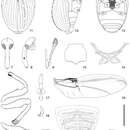Description
provided by Zookeys
Dark brown in general appearance. Head, rostrum, prothorax (except apical part), venter, and pygidium black; antennae, apical part of prothorax, and tarsi paler.
Vestiture. Body surface evenly covered with ochreous pollinosity in life. Head mainly covered with brown clavate scales, mixed with white scales; vertex with scales directed medially; forehead with scales directed basally; basal margin and median carina fringed with white ovate recumbent scales. Rostrum covered with clavate scales on basal 2/3; scales directed basally, gradually becoming smaller toward apex, replaced by hair-like scales on apical 1/3. Prothorax mainly covered with very similar scales as those on head, with longitudinal stripe of white ovate recumbent scales on median and lateral parts; each scale directed basally. Elytra (Fig. 11) bearing row of white and brown clavate scales on each interval; scales directed apically. Legs (Fig. 15) densely covered with white and brown scales; femora mostly covered with clavate semirecumbent scales, mingled with feather-like scales along inner margin; tibiae mainly covered with clavate scales, except semirecumbent hair-like scales along inner margin; corbel of each tibia fringed with brown setae. Lateral pieces of meso- and metathorax mainly covered with white ovate recumbent scales. Sterna mainly covered with white lanceolate to ovate scales; meso- and metaventral receptacles densely covered with white aciculate scales. Venter mainly covered with white lanceolate to ovate recumbent scales, mingled with white and brown clavate scales; ventrites III and IV nearly naked on disc, with only transverse row of clavate scales; ventrite V bearing fine brown scales in median concavity and white ovate scales on sides. Pygidium mainly sparsely covered with short clavate semirecumbent scales, mingled with hair-like recumbent scales; scales brown, directed ventrally.
Head (Figs 7–8) reticulately punctured; each puncture moderate in size; vertex with median carina from base to apex; carina becoming obscure apically; forehead shallowly depressed, with apex slightly broader than base of rostrum and then strongly widened basally; eyes medium-sized, rounded triangular, weakly convex. Rostrum (Figs 7–8) slender, evenly curved; dorsum densely rugosely punctured except apex; punctures moderate in size from base to level between antennal insertions, then becoming smaller, sparser, and shallower toward apex; sides subparallel in basal half, more or less widened before antennal insertions, then subparallel in apical part; antennal scrobes well separated on ventral surface. Antennae (Figs 8–9) inserted before middle of rostrum; scape moderate in length, evidently clavate, round and fringed with 3–4 setae at apex, slightly shorter than funicle; funicle six-segmented; club lanceolate, finely pubescent except basal part.
Pronotum (Figs 10–13) slightly wider than long; dorsum densely coarsely punctured, simple, lacking tubercle or prominence; punctures smaller in apical and basal parts; basal margin bisinuate, smooth, not serrate; apical margin weakly raised, with shallow median incision. Scutellar shield subovate.
Elytra (Figs 11–12) subcordate, nearly as long as wide, widest just behind humeri; suture evidently bent leftward; interval I of right elytron slightly broader than that of left elytron; all intervals subequal in width and height, nearly three times as wide as striae, each with row of more or less small and acute squamate granules; striae less marked, nearly naked, lacking conspicuous scales or hair, finely punctured; each puncture round, separated by distance more than three times as long as its diameter. Hind wings (Fig. 19) well-developed.
Legs (Fig. 15) slender; femora slightly clavate, each armed with small tooth, bearing minute squamate granules; no jumping organ present (Fig. 16); tibiae bearing minute squamate or setiferous granules; protibiae simple, lacking mucro and not curved in at apex; meso- and metatibiae moderately mucronate; corbels short, simple, not dilated outward; tarsi (Figs 17–18) moderate in length; claws free, slender, appendiculate with sharp teeth; each tooth slender, extending from base to middle of each claw.
Underside. Prosternum coarsely and moderately densely punctured; mesoventrite densely and finely punctured; metaventrite with dense medium-sized punctures on disc and with sparser and coarser punctures on sides; lateral pieces of meso- and metasterna sparsely coarsely punctured. Rostral channel (Fig. 13) long, extending far beyond level between posterior margins of mesocoxal cavities, with dense minute punctures; mesoventral receptacle deep, laterally costate; costae short, subparallel; metaventral receptacle very deep, terminating in steep wall and U-shaped margin; lateral walls of meso- and metaventral receptacles interrupted by inner margins of mesocoxae; metaventrite more or less prominent ventrally along apico-lateral margin of metaventral receptacle. Metendosternite as in Fig. 14. Venter coarsely and more or less densely punctured; ventrites III and IV nearly polished on disc, with only transverse row of coarse and sparse punctures; ventrite V with subtriangular median concavity along basal margin; concavity faintly sulcate along midline. Tergum as in Figs 20–21; tergite VII with pair of minute setiferous plectral tubercles near base.
Pygidium transverse-pentagonal, flattened, very coarsely and reticulately punctured; bottom of each puncture opaque due to dense minute punctations; upper flange arcuate downward on each side.
Rostrum (Figs 24–25) slightly more slender. Antennae inserted just behind middle of the rostrum. Tibiae simple, not mucronate on all legs. Ventrites I and II moderately inflated, sparsely punctured, lacking prominence. Ventrite V simple or only with longitudinal median sulcus, lacking concavity. Pygidium smaller, sectorial, mainly covered with hair-like scales. Otherwise as in male.
- license
- cc-by-3.0
- copyright
- Junhao Huang, Hiraku Yoshitake, Runzhi Zhang, Motomi Ito
- bibliographic citation
- Huang J, Yoshitake H, Zhang R, Ito M (2014) Taxonomic revision of the East Asian genus Scleropteroides Colonnelli, 1979 (Coleoptera, Curculionidae, Ceutorhynchinae) ZooKeys 437: 45–86
- author
- Junhao Huang
- author
- Hiraku Yoshitake
- author
- Runzhi Zhang
- author
- Motomi Ito
Distribution
provided by Zookeys
East Asia (China including Taiwan, Korea, and Japan; Figs 133–134).
- license
- cc-by-3.0
- copyright
- Junhao Huang, Hiraku Yoshitake, Runzhi Zhang, Motomi Ito
- bibliographic citation
- Huang J, Yoshitake H, Zhang R, Ito M (2014) Taxonomic revision of the East Asian genus Scleropteroides Colonnelli, 1979 (Coleoptera, Curculionidae, Ceutorhynchinae) ZooKeys 437: 45–86
- author
- Junhao Huang
- author
- Hiraku Yoshitake
- author
- Runzhi Zhang
- author
- Motomi Ito

